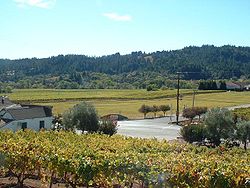Sonoma (wine)
Sonoma County wine is wine made in Sonoma County, California, in the United States.
County names in the United States automatically qualify as legal appellations of origin for wine produced from grapes grown in that county and do not require registration with the United States Department of the Treasury, Alcohol and Tobacco Tax and Trade Bureau.
Sonoma County is one of California's largest producers of wine grapes, far outproducing the Napa Valley AVA.
Grapes were planted in Sonoma County at Fort Ross as early as 1812. Padre Jose Altimira planted several thousand grape vines at Mission San Francisco Solano in what is now the city of Sonoma, in southern Sonoma County. Cuttings from the Sonoma mission vineyards were carried throughout the northern California area to start new vineyards. By the time of the Bear Flag Revolt in Sonoma and the subsequent annexation of California by the United States in 1854, wine grapes were an established part of agriculture in the region. The vineyards of General Mariano Vallejo, military Governor of Mexican California and based in Sonoma, were producing an annual income of $20,000 at that time. The grape varietals planted would not be considered premium varietals today.
In 1855, a Hungarian named Agoston Haraszthy arrived in Sonoma Valley. Upon his arrival, he purchased the Salvador Vallejo vineyard, which he then renamed it Buena Vista. Commissioned in 1861 by the California legislature to study viticulture in Europe, he returned with more than 100,000 cuttings of premium grape varietals. Many of the immigrants to the area were Northern Italian or from other wine-growing regions of Europe. After the Civil War and before Prohibition, wineries such as Bundschu, Foppiano, Korbel, Simi, Gundlach, Quitzow and Sebastiani were established that still exist.
...
Wikipedia

